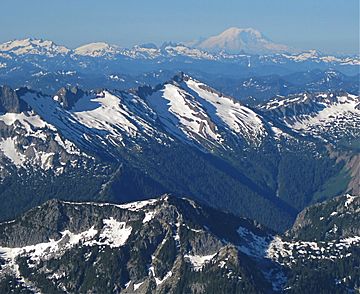Whittier Peak facts for kids
Quick facts for kids Whittier Peak |
|
|---|---|

Whittier Peak centered. Viewed from Clark Mountain
|
|
| Highest point | |
| Elevation | 7,281 ft (2,219 m) |
| Prominence | 521 ft (159 m) |
| Isolation | 2.23 mi (3.59 km) |
| Parent peak | Mount David (7,420 ft) |
| Geography | |
| Location | Chelan County, Washington, U.S. |
| Parent range | Cascade Range |
| Topo map | USGS Poe Mountain |
| Climbing | |
| Easiest route | Scrambling |
Whittier Peak is a mountain in Washington State, standing tall at 7,281 feet (2,219 meters). It is located in Chelan County, within the beautiful Wenatchee National Forest. This peak is part of the Glacier Peak Wilderness, a wild area in the North Cascades mountains.
The closest taller mountain to Whittier Peak is Mount David, which is about 2.26 miles (3.64 kilometers) away. Water from Whittier Peak flows into small streams that eventually join the Wenatchee River.
The mountain was named after a famous poet, John Greenleaf Whittier. It was named by Albert Hale Sylvester, who was a pioneer surveyor and explorer. He helped map the Cascade Mountains and named many places. He also named other nearby peaks after poets, like Irving Peak, Poe Mountain, Longfellow Mountain, and Bryant Peak.
How Were the Mountains Formed?
The North Cascades mountains, where Whittier Peak is found, have very rough and jagged shapes. You can see sharp peaks, tall spires, long ridges, and deep valleys carved by glaciers. These amazing shapes and big changes in height happened because of geological events that took place millions of years ago. These events also led to different types of weather in the Cascade Range.
The Cascade Mountains started forming millions of years ago, during a time called the late Eocene Epoch. This happened because the North American Plate (a huge piece of Earth's crust) slowly moved over the Pacific Plate. This movement caused volcanoes to erupt many times.
Glacier Peak, a large volcano, is only about 12 miles (19 kilometers) north of Whittier Peak. It began forming even later, during the mid-Pleistocene period. Because Glacier Peak is so close, you can often find volcanic ash in the area around Whittier Peak. Also, small pieces of Earth's crust, called terranes, came together to create the North Cascades about 50 million years ago.
During the Pleistocene period, which was over two million years ago, huge sheets of ice called glaciers moved across the land. They moved forward and then melted back many times. These glaciers carved out and shaped the landscape. The lifting of the land and cracks in the Earth's crust (called faults), along with the glaciers, are the main reasons why the North Cascades have such tall peaks and deep valleys today.
What is the Climate Like?
Whittier Peak is in a climate zone known as the marine west coast climate. This means it's influenced by the ocean. Most of the weather systems that bring rain and snow start over the Pacific Ocean. They then travel northeast towards the Cascade Range.
When these weather systems reach the North Cascades, the tall mountains force the air upward. As the air rises, it cools down and drops its moisture as rain or snow onto the Cascades. This process is called Orographic lift. Because of this, the western side of the North Cascades gets a lot of rain and snow, especially in winter.
The climate here is mild because it's close to the Pacific Ocean. Temperatures rarely go below 0°F (-18°C) or above 80°F (27°C). In winter, it's often cloudy. But in summer, high-pressure systems over the Pacific Ocean usually bring clear skies. Because the snow is influenced by the ocean, it tends to be wet and heavy. This can lead to a high risk of avalanches.




